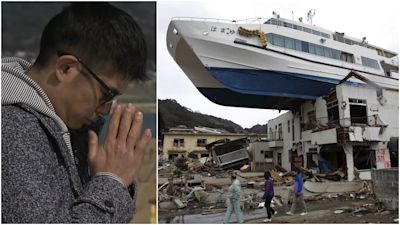Japan's catastrophic earthquake, tsunami and nuclear disaster remembered 10 years on

Ten years after Japan’s earthquake, tsunami and nuclear disaster, fears have turned into acceptance that life may never be the same again for survivors.
On March 11, 2011, one of the biggest quakes on record touched off a massive tsunami, killing more than 18,000 people and setting off catastrophic meltdowns at the Fukushima Daiichi nuclear plant.
Nearly half a million people were displaced, and tens of thousands still have not returned home.
More than 30 trillion yen (£201 billion) has been spent on reconstruction so far — but even reconstruction minister Katsuei Hirasawa acknowledged the government has invested less than it could have in helping people to rebuild their lives, such as offering mental health services for trauma.
On Thursday, the nation marked the anniversary with many walking to the coast carrying bouquets and visiting graves to pray for relatives and friends.
Emperor Naruhito and prime minister Yoshihide Suga were among those observing a moment of silence at 2.46pm – the minute the shaking started – at a memorial in Tokyo.
Prime Minister Yoshihide Suga and Emperor Naruhito pay respects
Ten years later, more than 40,000 people are still unable to return home in and around Fukushima, where areas near the wrecked plant are still off-limits due to radioactive contamination.
“Reconstruction in disaster-hit areas has moved forward significantly, but recovery of the survivors’ hearts is not making as much progress as we wish,” said Makoto Saito, a teacher at a primary school in Minamisoma, a town hit by the triple disaster where he lost his five-year-old son Shota in the tsunami.
Mr Saito, representing Fukushima survivors, said in his speech at the ceremony that he is afraid memories are fading outside the disaster zone and he is committed to keep telling the lessons from the disaster and stories of his son.
In Otsuchi town in Iwate prefecture, where the tsunami destroyed the town hall, killing about 40 employees, families in dark suits gathered on a piece of empty land where the building used to stand.
In Ishinomaki, Miyagi prefecture, dozens of residents prayed at a cenotaph carrying the names of more than 3,000 victims.
How are survivors still impacted?
Yasuo Takamatsu, 64, is one of many people whose lives were shattered by the disaster.
He lost his wife, Yuko, when the tsunami hit Onagawa, in Miyagi prefecture. He has been looking for her ever since.
Mr Takamatsu obtained a diving licence to try to find her remains, and for seven years he has gone on weekly dives – 470 and counting.
“I’m always thinking that she may be somewhere nearby,” he said.
As well as solo dives, Mr Takamatsu joins local authorities once a month as they conduct underwater searches for some 2,500 people whose remains are still unaccounted for across the region.
He said the city’s scars have largely healed, “but the recovery of people’s hearts… will take time”.
So far, he has found albums, clothes and other artefacts, but nothing that belonged to his wife.
He said he will keep searching for Yuko “as long as my body moves”.
And he added: “In the last text message that she sent me, she said: ‘Are you okay? I want to go home.’
“I’m sure she still wants to come home.”
About six miles south of the wrecked nuclear plant, rice farmer Naoto Matsumura defied a government evacuation order a decade ago and stayed on his farm to protect his land and the cattle abandoned by neighbours.
He is still there.
Most of the town of Tomioka reopened in 2017. But dozens of neighbouring homes around Mr Matsumura are still empty, leaving the area pitch black at night.
The Fukushima prefecture town’s main train station got a facelift, and a new shopping centre was built.
But less than 10% of Tomioka’s former population of 16,000 has returned after massive amounts of radioactive material spewing from the plant forced evacuations from the town and other nearby areas.
Parts of the town remain off-limits, and houses and shops stand abandoned.
Is the nuclear plant still dangerous?
About 900 tonnes of melted nuclear fuel remain inside the three damaged reactors, and its removal is a daunting task that officials say will take 30-40 years. Critics say that’s overly optimistic.
Separate efforts to remove spent fuel from cooling pools inside the reactor buildings were hampered by high radiation and debris and have been delayed for up to five years.
If the plant’s pools lose their cooling water in another major quake, exposed fuel rods could quickly overheat and cause an even worse meltdown.
The melted cores in Units 1, 2 and 3 mostly fell to the bottom of their primary containment vessels, some penetrating and mixing with the concrete foundation, making removal extremely difficult.
Remote-controlled robots with cameras have provided only a limited view of the melted fuel in areas still too dangerous for humans to go.
Plant chief Akira Ono says the inability to see what’s happening inside the reactors means that details about the melted fuel are still largely unknown.
Is there a solution?
Japan doesn’t yet have a plan to dispose of the highly radioactive melted fuel, debris and waste at the plant. Technology also isn’t advanced enough yet to manage the waste by reducing its toxicity.
Tokyo Electric Power Company (TEPCO) says it needs to get rid of the water storage tanks to free up space at the plant, so workers can build facilities that will be used to study and store melted fuel and other debris.
There are about 500,000 tons of solid radioactive waste, including contaminated debris and soil, sludge from water treatment, scrapped tanks and other waste.
It’s unclear what the plant will look like when the work there is done.
Local officials and residents say they expect the complex to one day be open space where they can walk freely.
But there’s no clear idea if or when that might happen.